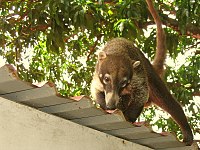
Photo from wikipedia
Abstract The South American coati Nasua nasua is a relatively common species throughout the Neotropical region. Despite this, ecological information on the species, including its biological interactions and habitat use,… Click to show full abstract
Abstract The South American coati Nasua nasua is a relatively common species throughout the Neotropical region. Despite this, ecological information on the species, including its biological interactions and habitat use, is scarce, especially for the Andes. In some regions, Nasua nasua is sympatric with other closely related species of the Procyonidae family, including the mountain coati Nasuella olivacea. Here, we assess the influence of environmental and anthropogenic factors on the occupancy of these two species and the spatial and temporal bases of their co-occurrence along an elevational gradient. Camera trapping (with 85 camera-trap stations) was conducted during the dry season of 2016 along elevations from 1600 to 3600 m above sea level (m. a. s. l.) in northern Peru. We observed a total of 244 detections for Nasua nasua and 17 for Nasuella olivacea over 9457 cumulative camera-days. Occupancy modelling (Royle-Nichols model) showed that Nasua nasua occupancy was significantly and negatively related to elevation but positively related to forest cover. In contrast, Nasuella olivacea occupancy was significantly and positively related to elevation. In addition, Nasuella olivacea was detected in only 5 of the 45 total sites occupied by Nasua nasua; therefore, spatial overlap was low. Consequently, co-occurrence modelling based on a Bayesian approach showed no evidence of avoidance between the two coati species. Additionally, activity patterns suggest low levels of temporal overlap; however, we consider this a preliminary finding due to the limited number of detections for Nasuella olivacea. Our results not only increase the understanding of the ecology of both Nasua nasua and Nasuella olivacea but also provide information towards their conservation in this part of their distribution range.
Journal Title: Mammalian Biology
Year Published: 2019
Link to full text (if available)
Share on Social Media: Sign Up to like & get
recommendations!